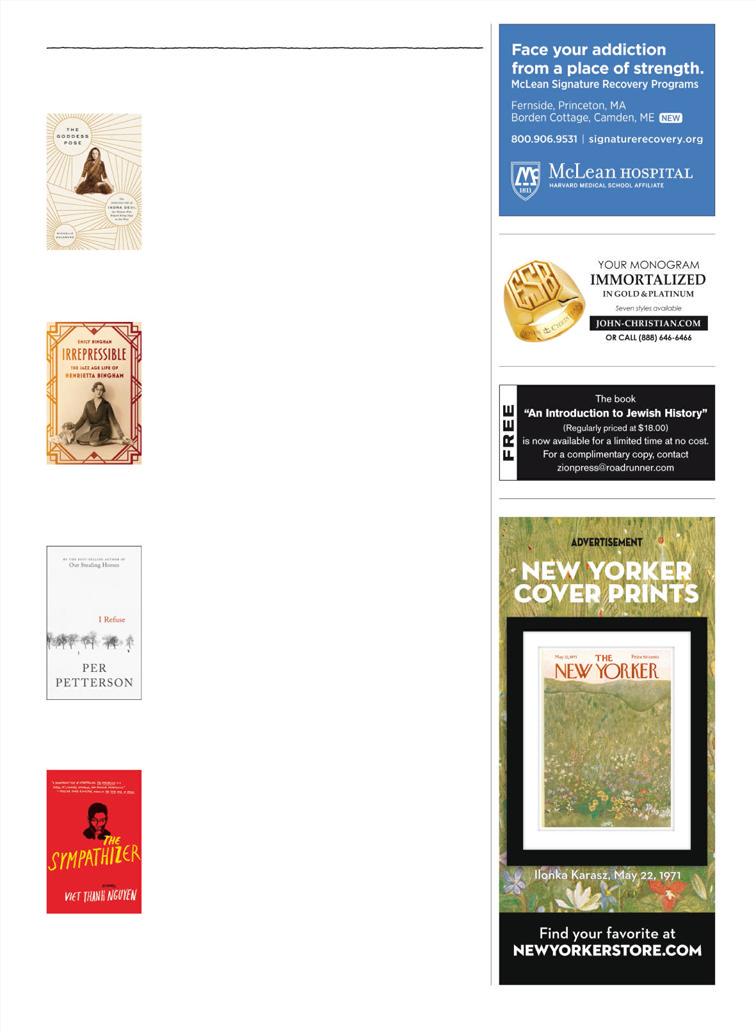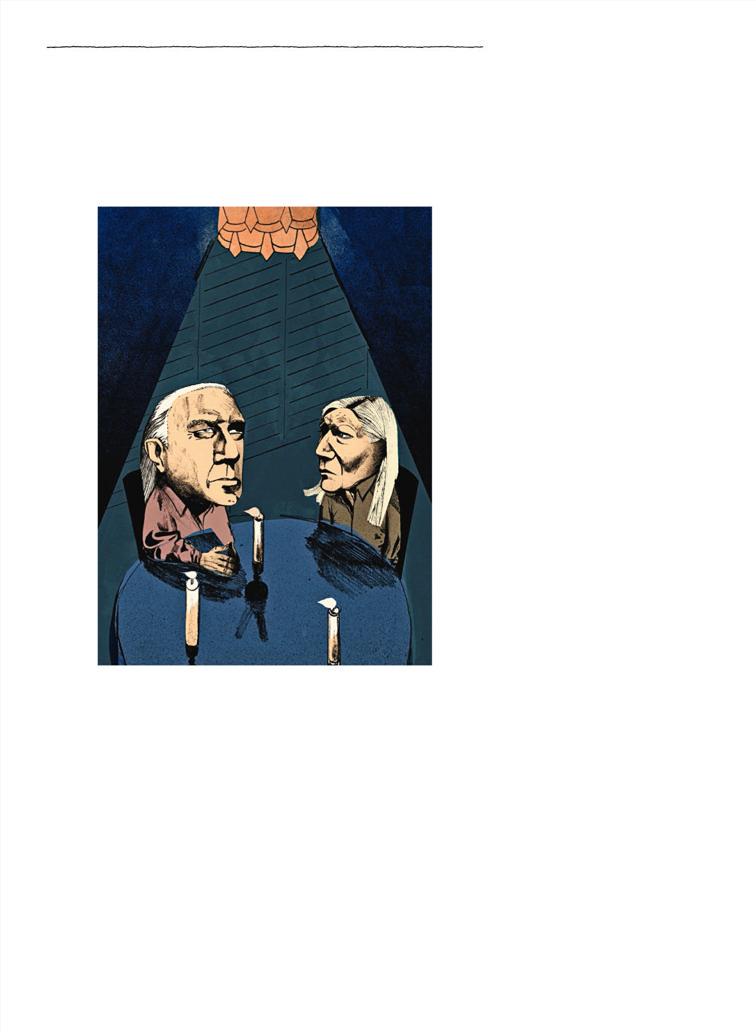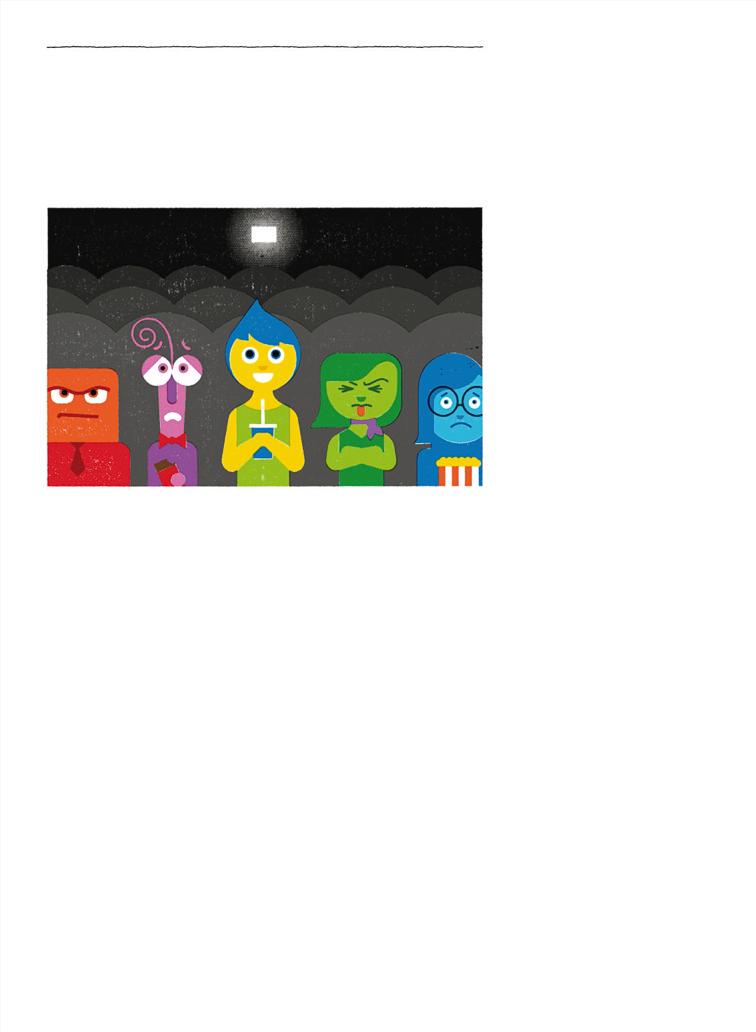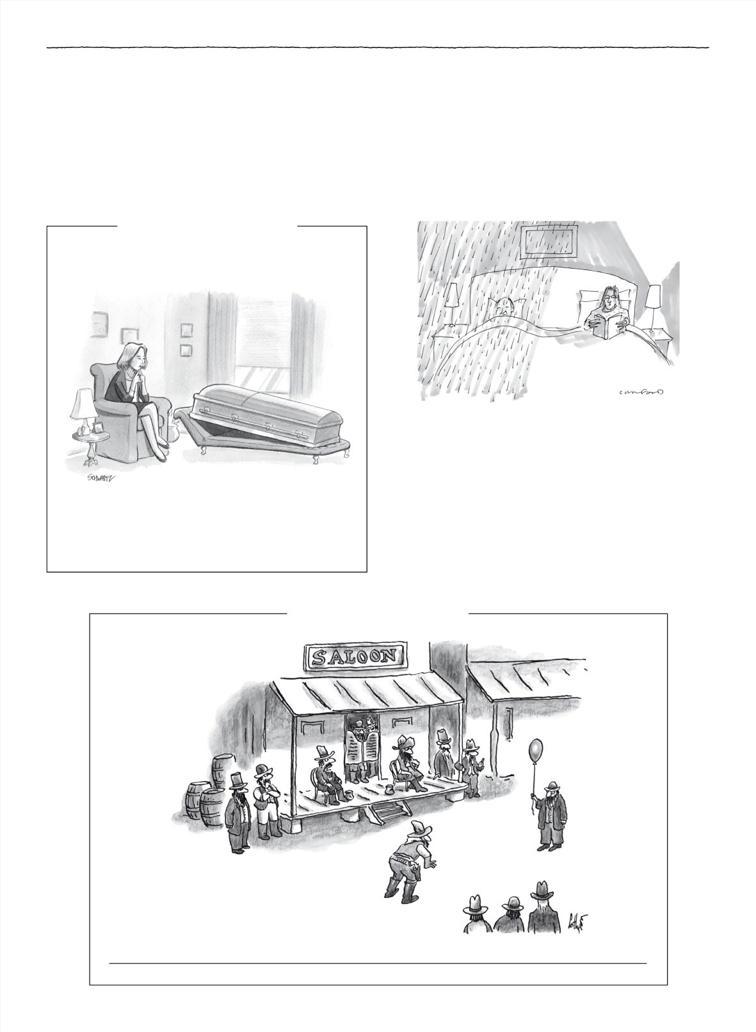
32 minute read
Briefly Noted
THE GODDESS POSE, by Michelle Goldberg (Knopf). “Traditional yoga is supposed to teach you how to renounce worldly goals,” Goldberg writes in this event-crammed biography. Yet for her subject, Indira Devi, yoga was about ambition. Born Eugenia Vassilievna, in 1899, she was a Latvian actress and socialite, who flitted through various jobs and countries before introducing yoga, still little known in the United States, in Los Angeles in the late forties. Greta Garbo and Gloria Swanson were among the clients at her studio, on Sunset Strip. The second half of Devi’s life, similarly fast-paced, included stints in Saigon, Mexico, and Buenos Aires. She lived to be a hundred and two.
IRREPRESSIBLE, by Emily Bingham (Farrar, Straus & Giroux). Henrietta Bingham, the great-aunt of the author of this haunting biography, is best remembered for her association with the Bloomsbury group. A wealthy, charismatic lesbian débutante from Kentucky, she traipsed about London singing to a mandolin and seducing everyone she met (she was Dora Carrington’s longtime lover). Yet, Bingham writes, she always felt like an outsider. As the Jazz Age gave way to a harsher moral climate, she sought a cure for her orientation: years of psychoanalysis, electroshock therapy, barbiturates, and the threat of a lobotomy ushered in a tragic demise. Bingham captures both the giddy rebellion of her aunt’s youth and her slow, startling unravelling.
Advertisement
I REFUSE, by Per Petterson, translated from the Norwegian by Don Bartlett (Graywolf). Set in Norway and covering half a century, this novel follows three childhood friends—Tommy, Jim, and Tommy’s younger sister, Siri—from adolescent trauma to the reckonings of middle age. Drinking, arson, a suicide attempt, and unsettled relationships all appear as fallout from an early confrontation between Tommy and his violent father. Characters take turns narrating, in a way that lends their struggles great immediacy, though Petterson’s choice of an episodic and nonlinear form muffles our sense of their development. Striking moments of reflection, as when Tommy and Jim travel or take in a gorgeously described landscape, bring agony to the forefront.
THE SYMPATHIZER, by Viet Thanh Nguyen (Grove). This comic picaresque set in nineteen-seventies California is narrated by a Vietcong mole who has allowed himself to be groomed by the C.I.A.—to the point where the Vietnamese Communists no longer recognize this Beatles-loving person as one of their own. The novel’s best parts are painful, hilarious exposures of white tone-deafness, from an Oriental-studies professor who calls his Japanese-American secretary “Miss Butterfly” to a buffoonish Hollywood director—inspired, Nguyen’s acknowledgments note, by Francis Ford Coppola—who hires the narrator as a consultant for a cumbersome melodrama. The ending, which involves scenes of torture and a dystopian epiphany, feels out of keeping with the rest of the book, but the preceding satire is delicious.
MR. POPULAR
Sam Hunt’s music is radio-friendly. But is it country?
BY KELEFA SANNEH
Every spring, the University of Al- abama at Birmingham hosts a concert by its gospel choir, a student group that is also an academic elective. (Participants earn an hour of class credit for each year of singing.) The 2008 concert featured a new spiritual, “Nothing Goes Unnoticed,” that paid tribute to the victims of the massacre at Virginia Tech, in 2007; audience members were given glow sticks so they could wave along. To perform it, the choir brought out an unlikely soloist: a shaggy-haired white guy in khakis and cowboy boots, who strummed an acoustic guitar and delivered the lyrics in a quavering twang. The singer was a celebrity, but not a musical one: Sam Hunt, known to the student body as the starting quarterback on the football team. And he sounded pretty good. A video recording of the concert shows him growing more self-assured as the song progresses—buoyed, no doubt, by the dozens of gospel singers behind him and by the hundreds of glow sticks before him.
After college, Hunt earned a tryout with the Kansas City Chiefs, who evidently were not looking for a singer. So he moved to Nashville, where he fared better, helping to write hits for country stars like Kenny Chesney and Keith Urban. The song he co-wrote for Urban was “Cop Car,” about a teenage trespasser who shares a stolen moment with his co-conspirator: “I fell in love in the back of the cop car.” Last year, Urban sang it at the Grammy Awards—a triumphant moment for Hunt, you might think, but he didn’t see it that way. In a memorable breach of Nashville decorum, he responded to the performance with a doleful tweet:

I worked hard on “Cop Car.” Everything I poured into that song was stolen from me. I unfortunately can’t celebrate it being on the Grammys.
Hunt didn’t explain how he lost control of “Cop Car,” but he did find a way to retaliate: by re-recording it for his début album, “Montevallo,” which was named after a town in Alabama where a former girlfriend lived, and which has established him as the fastest-rising new country star in years. The album, released last fall, is already responsible for two No. 1 hits on Billboard’s country chart, and its success has made his summer touring plans seem unreasonably modest. During a recent appearance at Jones Beach, on Long Island, booked long ago, he was the opening act for the opening act, which led to an unusual sight: an enthusiastic sing-along in a half-empty amphitheatre. Hunt wore a baseball cap and a gray T-shirt, snug enough to reassure fans that he could probably still heave a football deep into the secondary if the need arose. When he brought his wireless microphone into the crowd, he was swarmed by a throng of admirers, who were young, with few exceptions, and female, with none. He accepted the adulation with the unsheepish good cheer you might expect from a former jock—a guy whose popularity long predated his singing career.
Hunt grew up in Cedartown, Georgia, about an hour from Atlanta, and he has cited the city’s fertile R. & B. scene as an early influence. Back in his songwriter days, he released an independent album, “Between the Pines.” He called it an “acoustic mixtape,” and the casual performances—some of which seemed to have been recorded in bars, or maybe at house parties— showed off Hunt’s love of quick, syncopated vocal rhythms. Seven of those songs reappear on “Montevallo,” which is Nashville-slick, but with a light touch. “Make You Miss Me”—as in “Girl, I’m gonna”—is a breakup song with lyrics
that might sound resentful if they were set to a less wistful tune, or if they were delivered by a singer less willing to play the lovestruck loser. And in “Take Your Time,” a No. 1 hit this spring, Hunt begins each verse by speaking the lyrics instead of singing them—a technique that owes as much to old-school country-music talkers like Tex Williams and Conway Twitty as it does to contemporary hip-hop stars. Hunt is the latest in a string of hunky young singers who have populated country- radio playlists in recent years. Their convivial and flirtatious songs are sometimes called “bro-country,” a description invariably wielded as an insult, and not always fairly. But if Hunt is a bro he is a sensitive one, honing an imaginative and inclusive sound that may well take him beyond the bros—and possibly beyond country, too.
At Jones Beach, Hunt was accompanied by a couple of guitarists and a drummer, as well as by a pre-recorded backing track, which nudged his songs toward traditional country music (by adding a banjo lick, say) or toward pop (whooshing keyboards). He is not a particularly strong singer, which doesn’t have to be a disadvantage, especially for a performer whose lyrics tend toward the conversational. The goal is to encourage your fans to join their voices with yours, instead of marvelling at your high notes. He started his set with “Raised on It,” which builds to some rousing oh-oh-ohs, but finds time along the way to describe small-town life in a way that is both specific and widely applicable: “Duckin’ from your ex at the four-way stop / Turn the music down when you’re passing the cops.”
The sing-along stopped only once during Hunt’s set, near the end, in a moment designed to disorient the crowd. A sinuous, hazy electronic beat came through the speakers, and a disembodied voice intoned some surprisingly gloomy words: “All the sh— I do is boring / All these record labels boring / I don’t trust these record labels, I’m touring / All these people on the planet working nine to five, just to stay alive.” Some people in the crowd might have recognized the absent singer as Beyoncé, but probably not too many, since the clip came, lightly censored, from “Ghost,” one of the more experimental songs on her self-titled 2013 album. This was Hunt’s way of introducing “Single for the Summer,” a not wholly celebratory song about a man who finds himself seasonally unable to stay faithful. “I feel it creepin’ in,” he sang. “Every day’s a weekend, and I’m drowning in the freedom.” After the second chorus, he took another detour, delivering part of the third verse of “Marvin’s Room,” by Drake, another singer (and, more often, rapper) who elegantly slips between genres and moods; modern country singers love to flaunt phrases and attitudes borrowed from hip-hop, but Hunt’s borrowings are softer and sneakier. “Having a hard time adjusting to fame,” he murmured, following Drake’s example. It was the most memorable line of the night, even though he gave the crowd no reason to believe it.

Hunt’s pop sensibility may remind some listeners of another singer who released an album on the day that “Montevallo” came out: Taylor Swift. The album, “1989,” was a preordained blockbuster that presented country radio stations with a dilemma: whether or not to play it. Swift might be the biggest star the genre has ever produced, but the songs on “1989” make no concessions to the sounds and subjects that define country music. When the first single was released, a program director from Minneapolis suggested to USA Today that Swift had abandoned the genre. “I hope she gets the country muse again soon,” he said. “We’ll gladly welcome her back, whenever it is.” But some country stations have been playing songs from “1989” anyway, wagering that Swift’s popularity will outweigh the disappointment of listeners who expect something twangier.
Among those stations is Nash FM, in New York, one of four hundred and sixty stations owned by Cumulus Media. John Dickey is the company’s executive vice-president of content and programming, and he says that, especially in a cosmopolitan market like New York, it didn’t make sense to send Swift’s fans elsewhere simply because her new songs were too pop. In his view, country radio can and must expand musically, while retaining its “foundational tenets,” including a commitment to “wholesome entertainment” for families. Hunt, unlike some country mavericks, has been embraced by radio stations, which remain the genre’s most important arbiters. “What would have been a very difficult business proposition five, six, seven years ago with an artist like Sam Hunt—today, he’s a poster child for what’s right with the format,” Dickey says. “He’s such a force right now, we can’t get enough Sam Hunt on the radio.”
Last month, a country-radio consultant named Keith Hill earned himself scores of enemies by telling Country Aircheck, an industry magazine, that programmers should be careful not to play too many women singers. “If you want to make ratings in country radio, take females out,” he said, suggesting that records by women should make up no more than nineteen per cent of a station’s playlist. (He explained, rather cryptically, that men were “the lettuce in our salad,” and that women were the tomatoes.) “Women like male artists,” he said, adding that as many as threequarters of listeners are women. Artists and executives alike were quick to disavow Hill’s analysis; Dickey, for instance, says that in order for country radio to thrive the number of women singers on the air must grow.
Part of the fun of a radio-driven genre like mainstream country is watching executives scramble to give audiences what they seem to want. For a few years, that meant bro-country, which could prosper only as long as listeners, especially women listeners, appeared to love it. But this past December a new duo called Maddie & Tae topped Billboard’s country-airplay chart with “Girl in a Country Song,” an acerbic response to the bros. The lyrics mocked songs about generic women in bikinis, asking, “Being the girl in a country song / How in the world did it go so wrong?” In a subtler way, Hunt’s ascendance, too, is proof that Nashville is changing again, as it always does. At Jones Beach, he ended his set with “Break Up in a Small Town,” a wounded pop song about a guy who can’t avoid his ex-girlfriend. “You gotta move or move on,” Hunt sang: advice to a character who’s stuck, from a singer who isn’t.
TRUE LIES
David Mamet and the art of the con.
BY HILTON ALS
Illusions generated a lot of talk in post war American theatre. The truth is that no amount of reality could compete with the Holocaust. So there was a turning inward. In 1947, Tennessee Williams’s Blanche DuBois told audiences that she wanted not realism but “magic,” and that emotional honesty wasn’t necessarily synonymous with the truth. Six years later, in Arthur Miller’s “The Crucible,” a play inspired by the hysteria of the McCarthy era, a young girl’s fears and neuroses turned reality into fantasy, a weapon of suspicion and dread. When Mart Crowley’s “The Boys in the Band” opened Off Broadway, in 1968, it raised the curtain on certain aspects of gay male life, but it also showed that self-acceptance was still an illusion for gay people, who had spent too long struggling to breathe in the swamps of hatred and self-hatred.
Since the nineteen-seventies, David Mamet has been writing comedies and dramas in which illusion is less a subject than a quality of speech and character. Raised in Chicago during the Cold War, Mamet was still a young man when Saigon fell, in 1975. He grew up in a world defined by disassociation and violence, and many of his most interesting characters are con artists, who have no compunctions when it comes to doing what they have to do in order to survive and amass more—of anything, including dreams. They live by one fierce rule: fuck the other guy before he fucks you. By the time the scam-thick “Glengarry Glen Ross” premièred, in 1983, he had become the bard of the American get. His smalltime crooks, hucksters, and real-estate agents were extreme or broken manifestations of Aristotle’s rule about what makes a play a play. In a 1997 interview in The Paris Review, Mamet said:

The main question in drama, the way I was taught, is always what does the protagonist want. . . . Do we see the protagonist’s wishes fulfilled or absolutely frustrated? That’s the structure of drama. . . . People only speak to get something. . . . They may use a language that seems revealing, but if so, it’s just coincidence, because what they’re trying to do is accomplish an objective.
Mamet’s characters set up a con whenever there’s something to be had, even if it’s only a person’s innocence—an innocence that the con artist rejects, because why should anyone get off the hook of existence without his fair share of existential disappointment? In “Edmond” (1982), the mild-mannered title character confronts and is beaten by a crooked card dealer and his shill. Being brutalized frees Edmond to pursue his own bloodlust; he comes to feel that politeness is for chumps and violence is justifiable—just as John, the professor accused of sexual harassment in Mamet’s 1992 piece “Oleanna,” learns that brute force might even be what his tormentor is looking for, in place of all that unmanly talking and thinking. Like Saul Bellow’s Augie March, Mamet’s fast-talking guys are shysters in their own minds. They make conversations out of lists—of so-called facts or mundane details—and stories that never add up to anything, or come to an end, because liars and hysterics don’t know who they are unless they’ve got an audience. Like writers, they want to convince you by telling you the only story they think needs telling. “Prairie du Chien,” from 1979 (now in revival at the Atlantic Theatre Company, along with Mamet’s 1985 short play “The Shawl,” under the collective title “Ghost Stories”), stars a character who is called, simply, or not simply, Storyteller. The play opens in a train compartment. It’s 1910. The lights are low, and the locomotive is chugging west through Wisconsin. Stage left, two men sit at a table playing cards: the Card Dealer (Nate Dendy) and the Gin Player (Jim Frangione). Upstage right,
the Storyteller (Jordan Lage) is talking to the Listener (Jason Ritter). The Listener has his back to us; his son (Henry Kelemen) isn’t visible, either—for most of the thirty- minute piece, he’s asleep on a bench beside the Listener. Originally written for the radio, “Prairie du Chien” is, first and foremost, a play about voices, but then what Mamet play isn’t? Or isn’t, ultimately, about Mamet’s voice? Still, the look of the show is as important as what’s being said, and the scenic designer, Lauren Helpern, and the lighting designer, Jeff Croiter, have built a world in which the physical limitations weigh on us as heavily as the words.
The Storyteller, who is thin-framed and handsome—he looks like an exhalation of mentholated cigarette smoke— is a monologuist, more or less, and the tale he tells is strange, racial, and sexual. It involves a white couple who owned a farm and ran a store in Council Bluffs and had troubles. (The Storyteller never tells us what he does for a living, but it sounds like he is a travelling salesman.) One day in March, the wife—very pretty, kind-seeming—showed up in town with bruises on her hands. Her husband was jealous. The couple had words. Returning to the store in August, the Storyteller discovered the husband on his way to the farm to kill his wife, who he said was pregnant with someone else’s child. The Storyteller tried to stop the guy, but he knocked the Storyteller down and ran off. The Storyteller found the sheriff and they raced out to the farm. Then things got really weird. Not only was the barn burning but the farmer was hanging from a porch crossbeam, dead. Inside the house, a woman was crying; she told them to go to the burning barn, where they found a black man with a pitchfork stuck in his heart. “It was sickening,” the Storyteller says. “Five feet away there was the woman. In this lovely dress. This red dress. On her face. Her back was blowed away. . . . And the barn’s about to go.” But that’s not the end of the tale. Meeting the sheriff outside the barn, the Storyteller described what he’d seen. The sheriff argued that it wasn’t possible: the woman in the red dress was in the house, alive.
The Storyteller doesn’t impersonate the characters in his gothic tale. Instead, before each character speaks, he pauses for a moment, though not long enough to break the spell. But why is he weaving a spell, and out of such unpleasant material? When the Gin Player discovers that the Card Dealer has been cheating, he pulls a gun, the eerie calm of the scene explodes, and so do we—with questions. Is the Storyteller part of the Dealer’s con? Or is the Dealer working with the Listener? When the train stops in the prairie, the Dealer exits, and the Storyteller decides to stretch his legs. But first he asks, as he does at the beginning of the play, if the Listener’s son is asleep, saying, “I’d give a lot to sleep like that.” Perhaps the Storyteller, if he’s complicit in the Dealer’s con, feels guilt or remorse about how he makes a living. Or perhaps he just knows that the quickest way into any mark’s heart is to express concern for his child. Or is the child, too, part of the con? Presumed innocents are anything but. It’s all just another illusion.

Unlike Blanche DuBois, Mamet’s characters aren’t looking for magic. They’re looking to disabuse others of the ridiculous desire to believe in a trusting, loving world. Miss A (the always compelling Mary McCann), in “The Shawl” (which, like “Prairie du Chien,” is directed, with commitment, by Scott Zigler), is a lonely figure, who lives in her memories of childhood. To find out who she was—and what she might be— she visits a psychic named John (Arliss Howard) in his shuttered apartment. John sports a gray ponytail; his hands make little florid gestures whenever he gets excited about anything. He knows that Miss A is an unloved person; he can get to her—and to her money—by making her believe that he will be a kind of friend to her. (In order to get to her money herself, Miss A has to contest her mother’s will.) John also longs for companionship. He expresses his love for Charles (Jason Ritter) by revealing his secrets to him. No one is “psychic,” John explains. His insight into Miss A’s past life has everything to do with guesswork. For instance, she’s right-handed, right? When right-handed people fall, he says, they often break the fall with their left knee. So he guesses that Miss A has a scar on her left knee—and she does.
“The Shawl” is a portrait of exploitation and of how the con can become one’s identity. Con artists feel lonely, or lonelier, without it. Will Charles love John if he lets him in on how he conducts his business? Will Miss A trust John if he keeps getting her story right? (And will that trust lead to much-needed funds?) Eventually, Miss A confronts John with at least one truth: the photo she showed him on one visit wasn’t actually of her mother; she cut it out of a book. How could he be fooled like that? John can’t answer the question properly; in any case, he doesn’t have to. He draws Miss A back in with a vision of her mother wrapping her in a shawl, a moment of maternal tenderness that Miss A never forgot and never mentioned to anyone. How did John know about it? He can’t explain his insight, but it’s enough for Miss A to believe that, because he knows her past, he knows her. Miss A needs to believe in John, just as John must believe in the con in order to keep her enthralled in his world of illusions. Toward the end of the play, there’s this tense exchange:
MISS A: You saw her.
JOHN: Did I see her? . . .
MISS A: No. You must tell me. You must tell me. You saw her.
JOHN: Yes.
MISS A: You saw her wrap me in that shawl.
JOHN: Yes.
MISS A: And you say I lost it.
JOHN: You, yes, that is what I said. But you did not lose it. You burnt it. In rage. Standing somewhere by water, five years ago.
MISS A: Yes. And then I . . . ?
JOHN: I do not know. That is all I saw.
Italics are used to emphasize a point, and one of the points Mamet is making here is, again, about storytelling: Miss A, a kind of storyteller herself, wants to know what happened next. Was it this or that? Miss A and John are a grift-driven Mike Nichols and Elaine May, improvising the truth in ways that suit their shared, false spiritual awareness. In the end, we don’t know if Miss A stands to inherit any money, or if the lure of cash is just her way of keeping John interested. John and Miss A are victimized by their loneliness, and they want to victimize other people because of it.
These dense and elegant plays are exemplary not only of Mamet’s protean talent but of what can happen to you if you expect some kind of Aristotelian payoff—the usual Western dramatic con—before you leave the theatre. Neither play ends with a catharsis, and, by refusing us a satisfying release, Mamet turns us sideways and inward to look at his savage world view, in which the hunter becomes the game. ♦
HEAD TRIPS
BY ANTHONY LANE
Anger, Fear, Joy, Disgust, and Sadness co-star in Pete Docter’s new film for Pixar.
The new Pixar film, “Inside Out,” is about the life of Riley. She is an only child (voiced by Kaitlyn Dias) who, aged eleven, moves with her parents (Diane Lane and Kyle MacLachlan) from Minnesota to San Francisco. Not much happens: she attends a new school, tries out for the hockey team, and misses her old home. That’s it. No talking cars or robots are involved, and there’s not a superhero in sight. The bulk of the movie takes place out of sight, within the confines of Riley’s mind, where primary feelings affect her every move. There are five in all: Joy (Amy Poehler), who is butter-yellow and fuzzy at the edges; Anger (Lewis Black), who looks like SpongeBob soaked in blood; Fear (Bill Hader), a writhing dweeb with a bow tie; Disgust (Mindy Kaling), who has frosted green hair and lashes; and Sadness (Phyllis Smith), a bespectacled blob of blue. Now and then, they contend for supremacy, but mostly they join forces and react to the world beyond. They behold it through Riley’s eyes, from a spiffy control center, like Kirk, Spock, and the gang on the bridge of the Enterprise.
Joy and the others are not alone. Around them stretches the vast landscape of Riley’s consciousness, with a train of thought puffing through it at irregular intervals, and other characters wandering about, such as Bing Bong (Richard Kind), an imaginary friend from Riley’s past, who weeps candies, and an imaginary, floppy-haired boyfriend from her future (“I would die for Riley,” he says). Dreams are produced in—where else?—a dream factory, with soundstages and camera crews. It closes down when she wakes. Experiences are delivered to the control room as if they were bowling balls, colored according to their mood; some are stored away, others dropped into a pit of forgetfulness, where they darken and crumble like spent coals, and a few are enthroned as core memories. And that, we are told, is how a personality is made.
So brisk is the defining of all this, and so efficiently does the director, Pete Docter, give us the guided tour, that we barely pause to consider the assumptions behind it. Pixar, though part of Disney, has no time for old-school habits, like lodging the emotions in the heart: a superfluous organ, it would seem. They are located squarely in the brain, presumably displacing Reason, whom we never meet, but whom I picture as French, bald, and wearing an English suit. The presence of Disgust— rather than Boredom, say, or a bristling Envy (which Riley would certainly need if she had a sibling)—points to a fastidiousness that has typified Pixar from the start. Joy is very much the captain of the team, but, as events unfold, Sadness comes to the fore, demonstrating that it’s O.K., and maybe even helpful, to feel low. Neurologists and therapists will examine the movie and pronounce themselves largely sat isfied. Has the studio ever supplied a more intensely American product, or one more guyed to the anxieties of middle- class aspiration? Five great islands dominate Riley’s psyche: Family, Honesty, Friendship, Hockey, and Goofball, better known as messing around. Each is vulnerable to threat; when Riley borrows her mom’s credit card without asking, the isle of Honesty flakes away. Riley also detests her new house, which looks like a perfectly nice property in a safe neighborhood, and she and her parents are mightily vexed by the late arrival of their stuff in the moving van. A similar vehicle, remember, figured in the climax of “Toy Story,” another tale of a childhood defined by its belongings. So much to worry about, in such an easy life!
On the scale of inventiveness, “Inside Out” will be hard to top this year. As so often with Pixar, you feel that you are visiting a laboratory crossed with a rainbow. Even through the graying veil of 3-D glasses, the sheen of the image is so acute that it aches, and the movie, aglow with domestic yearnings, should act upon viewers as “Meet Me in St. Louis” did in 1944. But who will those viewers be? And might they miss the clearer and less exhausting narrative flow of “Toy Story”? I saw Docter’s film with a sizable crowd, and noticed a definite rustle of impatience among the smaller kids during the more outré scenes—like the journey that Joy and her pals take through Abstract Thought, which flattens them first to 2-D geometric forms and then to mere lines. They emerge as random stars, as if in a Miró painting, before popping back into shape. Pixar’s vision of conceptual activity, in short, is a trip, and it

sticks out like Dali’s dream sequences for Hitchcock’s “Spellbound.” I sensed, at such moments, that I was following the transcription, by very clever adults, of their own theorizing—literate, frantic, and endlessly chewed over—on the subject of human development, rather than the story of a growing girl.
That is why the biggest laughs, without exception, come when we exit Riley’s head and take a quick vacation to the crania—and the mania—of others. During an argument at dinner, for instance, her father’s emotions are miles away; all of them are watching a hockey game. And, as the closing credits approach, Docter, realizing that he has a pack of wild gags that have been kept leashed for too long, releases the lot in a flurry. We peek inside the mind of a dog, a cat, a prepubescent boy (“Girl! Girl!” the alarms sing out), and, best of all, the cool chick with eyeshadow at Riley’s school, voiced by Rashida Jones. (Mind you, I would die for Rashida.) You start to wonder what a grownup sequel to “Inside Out” would look like, with a host of new feelings barging into central command and wrenching the controls away from Joy. Would Lust be spoken by Rupert Everett, or would it sound more like Chico Marx, working his way through a chorus line? How about Love of Money, or black-browed Mortal Terror? There are places, I guess, where even Pixar cannot go.

Bulky and bearded, a man lies alone in the dark. Flesh bulges at his waistband. He stirs like a bear emerging from hibernation, and we wonder what troubles may have roused him. Handguns clutter a table beside him, as if they were coffee cups, and yet, even at this late hour, he takes the time to call his mother, and together they say a prayer. Such is the beginning of “Escobar: Paradise Lost,” directed by Andrea Di Stefano. The big man is Pablo Escobar, the pasha of an international drug trade. The name has dwindled, these days, but there was a time when it was larded with awe and dread. “Medellin, Colombia—June 18, 1991,” we read onscreen, and, just to prove it, Escobar’s portable phone is a kind of metal baguette.
He is played by Benicio Del Toro, who is seldom easy to cast, especially as a lead, for his pleasure is to sidle into the action from the wings, with his sly and drowsy gaze and the viscous slur of his voice. That is why he made more of an impact in the bit part of Fenster, in “The Usual Suspects,” than he did in four and a half hours, as the star of Steven Soderbergh’s “Che.” In “Escobar: Paradise Lost,” Del Toro has finally found a character who fits him, and if there is a temptation to revel so heartily in the role that it bursts at the seams, he resists it. Early on, a bunch of nervous guys sit awaiting Escobar, whose status is not far short of a myth. Rather than make an entrance, however, he comes into the room as if he were one of them, wearing soccer shorts and conversing quietly. Likewise, the only weapon that we see him fire is a water pistol, in his swimming pool; if there must be blood, he has hirelings to do the shedding. Del Toro’s whole performance is an education in the steady hum of power. Fear not the man who swaggers and rants, he suggests, but the man who has no need to do so.
So why is Escobar not granted dominion over the film that bears his name? For some reason, what interests Di Stefano, consuming large portions of his movie, is the story of Nick (Josh Hutcherson), an aimless Canadian youth who hangs out on a Colombian beach and falls for a girl named Maria (Claudia Traisac). He is welcomed by her nice Uncle Pablo—none other than Escobar, who invites the couple to his estate, complete with stables, elephants, and a bullet-riddled car that belonged to Clyde Barrow. Nick, slow on the uptake, is a little bemused by the style in which Pablo likes to live. “How did he make all this money?” he asks Maria, obviously expecting her to say, “Dairy farming” or “Soft furnishings.” His proud host, always at ease in the witching hour, wanders into Nick’s bedroom one night and inquires, “Do you believe in God?” “Yes.” “Take drugs?” “No.” “That’s good.” Whether or not this counts as a job interview, Nick soon finds himself embroiled in the family business and unable to get out, at which point “Escobar: Paradise Lost” turns into a regulation thriller, equipped with shootings and sticks of dynamite. Meanwhile, everyone in the theatre is thinking: Given that I paid good money to learn about the world’s most frightening cocaine king, why am I watching a movie about the world’s most stupid Canadian?
newyorker.com
Richard Brody blogs about movies.
THE NEW YORKER IS A REGISTERED TRADEMARK OF ADVANCE MAGAZINE PUBLISHERS INC. COPYRIGHT ©2015 CONDÉ NAST. ALL RIGHTS RESERVED. PRINTED IN THE U.S.A.
VOLUME XCI, NO. 18, June 29, 2015. THE NEW YORKER (ISSN 0028 792X) is published weekly (except for five combined issues: February 23 & March 2, June 8 & 15, July 6 & 13, August 10 & 17, and December 21 & 28) by Condé Nast, which is a division of Advance Magazine Publishers Inc. PRINCIPAL OFFICE: Condé Nast, 1 World Trade Center, New York, NY 10007. Elizabeth Hughes, publisher, chief revenue officer; Beth Lusko, associate publisher advertising; James Guilfoyle, director of finance and business operations; Fabio Bertoni, general counsel. Condé Nast: S. I. Newhouse, Jr., chairman; Charles H. Townsend, chief executive officer; Robert A. Sauerberg, Jr., president; David E. Geithner, chief financial officer; Jill Bright, chief administrative officer. Periodicals postage paid at New York, NY, and at additional mailing offices. Canadian Goods and Services Tax Registration No. 123242885-RT0001.
POSTMASTER: SEND ADDRESS CHANGES TO THE NEW YORKER, P.O. Box 37684, Boone, IA 50037 0684. FOR SUBSCRIPTIONS, ADDRESS CHANGES, ADJUSTMENTS, OR BACK ISSUE INQUIRIES: Please write to The New Yorker, P.O. Box 37684, Boone, IA 50037 0684, call (800) 825- 2510, or e-mail subscriptions@newyorker.com. Please give both new and old addresses as printed on most recent label. Subscribers: If the Post Office alerts us that your magazine is undeliverable, we have no further obligation unless we receive a corrected address within one year. If during your subscription term or up to one year after the magazine becomes undeliverable, you are ever dissatisfied with your subscription, let us know. You will receive a full refund on all unmailed issues. First copy of new subscription will be mailed within four weeks after receipt of order. For advertising inquiries, please call Beth Lusko at (212) 286-4454. For submission guidelines, please refer to our Web site, www. newyorker.com. Address all editorial, business, and production correspondence to The New Yorker, 1 World Trade Center, New York, NY 10007. For cover reprints, please call (800) 897-8666, or e-mail covers@cartoonbank.com. For permissions and reprint requests, please call (212) 630-5656 or fax requests to (212) 630-5883. No part of this periodical may be reproduced without the consent of The New Yorker. The New Yorker’s name and logo, and the various titles and headings herein, are trademarks of Advance Magazine Publishers Inc. Visit us online at www.newyorker.com. To subscribe to other Condé Nast magazines, visit www.condenet.com. Occasionally, we make our subscriber list available to carefully screened companies that offer products and services that we believe would interest our readers. If you do not want to receive these offers and/or information, please advise us at P.O. Box 37684, Boone, IA 50037 0684 or call (800) 825-2510.
THE NEW YORKER IS NOT RESPONSIBLE FOR THE RETURN OR LOSS OF, OR FOR DAMAGE OR ANY OTHER INJURY TO, UNSOLICITED MANUSCRIPTS, UNSOLICITED ART WORK (INCLUDING, BUT NOT LIMITED TO, DRAWINGS, PHOTOGRAPHS, AND TRANSPARENCIES), OR ANY OTHER UNSOLICITED MATERIALS. THOSE SUBMITTING MANUSCRIPTS, PHOTOGRAPHS, ART WORK, OR OTHER MATERIALS FOR CONSIDERATION SHOULD NOT SEND ORIGINALS, UNLESS SPECIFICALLY REQUESTED TO DO SO BY THE NEW YORKER IN WRITING.
Each week, we provide a cartoon in need of a caption. You, the reader, submit a caption, we choose three finalists, and you vote for your favorite. Caption submissions for this week’s cartoon, by Frank Cotham, must be received by Sunday, June 28th. The finalists in the June 8th & 15th contest appear below. We will announce the winner, and the finalists in this week’s contest, in the July 20th issue. The winner receives a signed print of the cartoon. Any resident of the United States, Canada (except Quebec), Australia, the United Kingdom, or the Republic of Ireland age eighteen or over can enter or vote. To do so, and to read the complete rules, visit contest.newyorker.com.
THE WINNING CAPTION
“You’ve achieved closure.” Darren Gersh, Chevy Chase, Md.

THE FINALISTS
“An optimist would see the room as half dry.” Mark Conacher, Toronto, Ont.
“Not everything is about you.” Eric Tobiason, Torrance, Calif.
“It was a partially dark and stormy night.” Kathryn El-Assal, Middleton, Wisc.
THIS WEEK’S CONTEST





